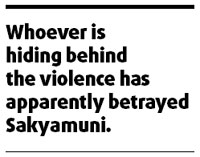Buddhist teachings not followed
By Zhou Yan (China Daily)
Updated: 2008-03-25 07:31
Updated: 2008-03-25 07:31
I wonder what Sakyamuni, the founder of Buddhism, would say had he witnessed the violence in Lhasa and other Tibetan-inhabited counties in Western China in the past week.
Though the commandments followed by Tibetan Buddhists vary, they are all based on "four precepts": no killing, stealing, adultery, or lying.
The Gelugpa School, or the yellow sect, of Tibetan Buddhism, headed by the Dalai Lama, is said to be observing these commandments strictly.

But what happened in Lhasa and several Tibetan communities in Gansu and Sichuan provinces was contrary to Buddhist teachings.
There were killings as we saw on TV footage of knife-wielding rioters taking to Lhasa's streets on March 14, hacking, beating and burning 18 innocent people to death.
Not to mention those who narrowly escaped: a 6-year-old boy trampled by rioters; a middle-aged couple who suffered burns and fractures but managed to escape by jumping out of their second-floor window.
Latest figures by the Tibetan regional government show 382 others were injured in the riot.
School buildings and shops were set ablaze, banks and shops were looted, and police cars and private vehicles torched.
On Thursday, the Dalai Lama told reporters in Dharamsala, India: "One hundred times, thousand times I have repeated this. It is my mantra - we are not seeking independence."
Yet the Tibetan Youth Congress vowed to pursue "Tibet independence" at the cost of blood and lives in a March 10 statement, which said "they would never give up the fight for Tibet independence".
On the same date, the group launched a so-called "March to Tibet" in India. Organizers claimed that once they were blocked outside China, they would stage protests and instigate followers to emulate them by making trouble inside China.
After the riots broke out in Lhasa, the Dalai clique maintained real-time contacts with the rioters, via e-mails and by sending videos, and dictating instructions to his hardcore devotees and synchronized their moves, police sources said.
So who is lying? The members of the Dalai clique or the rioters they backed, who shouted "Tibet independence" and waved the flag of the "Tibetan government in exile"?
Their plot certainly left the sacred city of Lhasa weeping and bleeding. But it will not taint the faith of the Tibetans.
Ask Losang Cering, a Tibetan doctor, who suffered a broken cheekbone and cerebral concussion. He would tell you he did not regret helping a six-year-old boy and his father of Han ethnicity.
Ask Canadian tourist Susan Wetmore, who happened to witness the Lhasa riots, and she would tell you how a taxi driver risked his life to get her to Lhasa's Gonggar Airport.
Ask Zhoi'ma, from Nyingchi, who admitted he was paid "several hundred yuan" a day to loot, beat and set fire.
And ask Qoizhag, a retired policeman, whose mother died under the whip of serf-owners. At 6 years old, he fled to the Drepung Monastery to become a monk. After the Communist Party of China ended serfdom in Tibet he was able to go to school.
"The Dalai Lama preached benevolence," Qoizhag, 67, said. "All that I saw was the whip, plus the recent violence."
The faithful in Tibet are following Sakyamuni; whoever is hiding behind the violence has apparently betrayed him.
Xinhua News Agency
(China Daily 03/25/2008 page9)
|
|
|
|